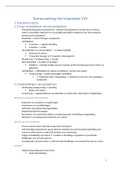HRM IN OVERHEIDSORGANISATIES
SAMENVATTING
,Instrumental dimension: rules, procedures, work systems, administraton, paperwork, …
Handles instrumental and administratie aspects of HRM
People dimension: motiaton, workin conditons, leadersh,ip, internal communicaton
Approaches the human side of enterprise
Strategic dimension: strate y, oals and objecties, measurement, added ialue
Deals with the strategic and the goal-directed aspects of HRM
Organizatonal dimension: structure and culture, or anizatonal desi n, or anizatonal deielopment
Goes into the cultural and structural elements of the organizaton
Eiery dimension includes a specifc role paaern that giies rise to the deielopment of the professionalism of a
Human Resource Manager.
1. Instrumental behavior: can lead towards tech,nocrats (het zakelijke is belangrijker dan het sociale), fanatc
administrator, excessiie trust in law and rules
The exaggerated aaenton to rules and procedures leads to a bureaucratc organizaton (= rigidity and
impersonality), but on the other side, the lack of instrumental systems leads to chaos
2. People management: can lead towards excessiie atenton to people and ne lect of results
3. Strategic manager: can lead to th,e dreamer, unrealistc iisionary
4. Organizatonal development: can lead to structuralism th,inkin , people follow structure
,PART I. THE INSTRUMENTAL DIMENSION
1. THE BASIC ELEMENTS OF THE INSTRUMENTAL DIMENSION
1.1 The history of administratve control toward internal service
First mana ement th,eories: Taylor, Fayol,… oal: fnd one best way to produce as efciently as
possible and to deploy employees as adequately as possible
o Taylor: tech,nical or anizaton of th,e producton process
o Fayol: administratie and mana erial aspects of th,e or anizaton (scientfc mana ement)
o Weber: bureaucracy
o Person and or anizaton as a mach,ine (“l’h,omme mach,ine” (quote from de La Metrie, French,
ph,ilosoph,er 18th, century))
o Predictability and security
o Industrializaton
o Syner y business people and academics ( eh,eel is meer dan som ian de delen)
Actualizaton: McDonaldizaton (Ritzer)
o = th,e process by wh,ich, th,e principles of th,e fast food restaurant are comin to dominate
more and more sectors of Americam Society as well as th,e rest of th,e world
o = th,e permanent presence of mech,anical th,inkin in specifc sector of our society (control,
specializaton of labour, infrmity, mass producton, routne)
o Efciency: realizin a task as quickly as possible (optmal employment of means)
o Calculability: th,e tendency to calculate eieryth,in
o Predictability: uniformizaton/standardizaton of products, seriices, procedures will increase
predictability (e. . in McDonalds you h,aie a h,i h, predictability of th,e meal)
o Control: control systems th,rou h, th,e use of tech,nolo y
o Discussion of McDonaldizaton: adianta es and disadianta es
Today: th,e importance of administratie control
o Importance of procedures
o Introducton of disciplinary interientons (tendency to natural soldierin )
o Measurement of labour productiity as one of th,e frst HRM measurement systems
o Re istraton systems
o Operatonal research,
, o Diferent aspects of instrumental tasks:
Administraton
Seriice deliiery
Juridical seriice
Expertse in administratie procedures and le al afairs
Ne otatons with, social partners for setn up re ulatons, rules, a reements, social
laws
th,e instrumental dimension is based upon a socio-le al system of ri h,ts and obli atons for
employer and employee administratie systems (rules, procedures, laws) are deieloped to
create th,e necessary distnctness and le al certainty in an or anizaton
1.2 The role of social partners in setng op instrumental systems
Ne otatons with, social partners: th,ey play an important role in new rules and procedures
Th,e role of employer (or anizatons), trade unions and oiernment in setn up socio-economic
regulatons
Results: socio-economic policy making
Leadin in some countries to Neo-Corporatst insttutons (neo-corporatsm = a system of
consultaton and policy makin in industrialized countries by wh,ich, th,e oiernment and social
partners come to socio-economic a reements in a tripartte consultatie structure)
Two models: th,e Rh,ineland model is th,e An lo-Saxon model in HRM
o Rh,ineland Europe: insttutonal re ulatons between trade unions and employers (led to
satsfacton of social partners) stron infuence on socio economic framework
o An lo-Saxon: USA: neoliberal, trade unions h,aie no decision powers
o diferent approach,es to HRM
Th,e importance of socio-economic stakeh,olders in HRM (th,e so called “socio-economic partners”)
1.3 The core business of the instrumental dimension
1.3.1 The administratve service: the necessity of paperwork
Recruitment formalites, follow-up of personnel fles, salary administraton, labour re ulatons
Th,e ur e for h,i h, quality seriice deliiery
Th,e importance of workin for a client
Internal mana ement = or anizin sch,edules, h,olidays, work systems,…
Diference between transactons (routnes, automatc tasks) and transformatons (ch,an e, add more
ialue, transformaton of situatons, problem soliin )
Transactonal (low added valuek Transformatonal (high added valuek
Routne based Non routnes, not 100% predictable, project based
Relatie easy process Relatie complex proces
Mostly not personal Need for personal contact
Require more tech,nical, juridical and mana erial
Low competencies required
expertse
Basic seriice Complex seriice, ch,an e processes



